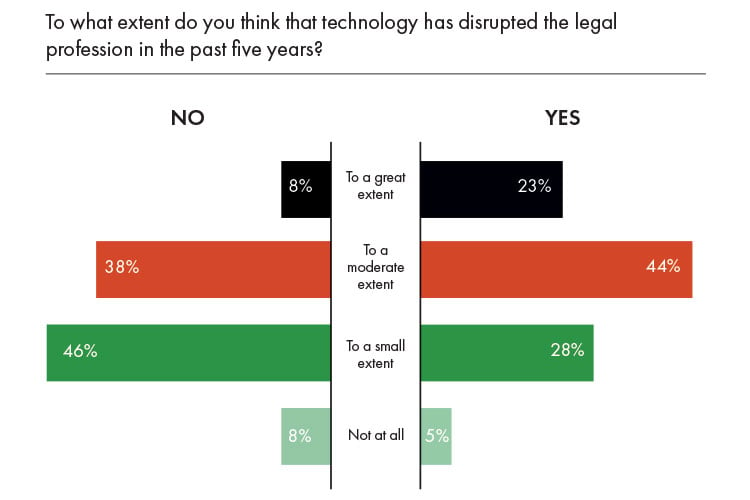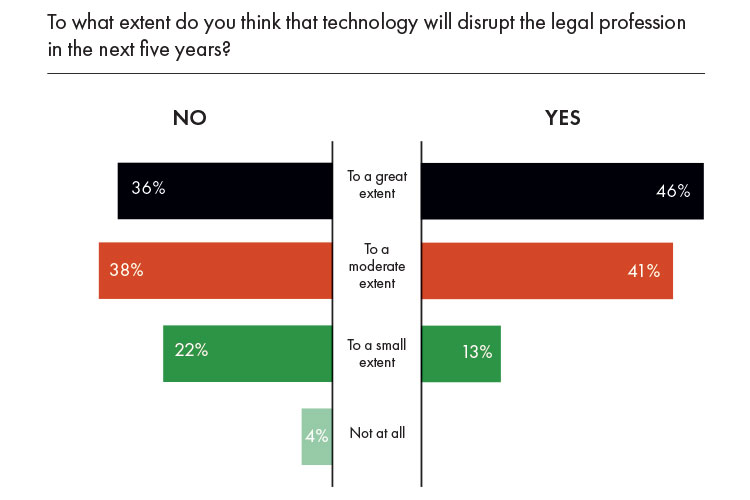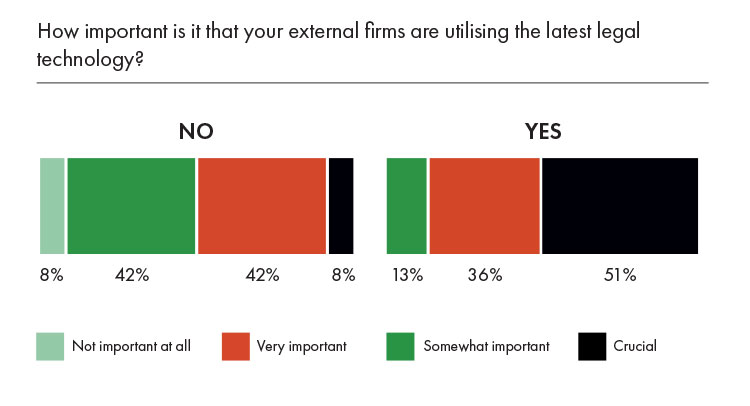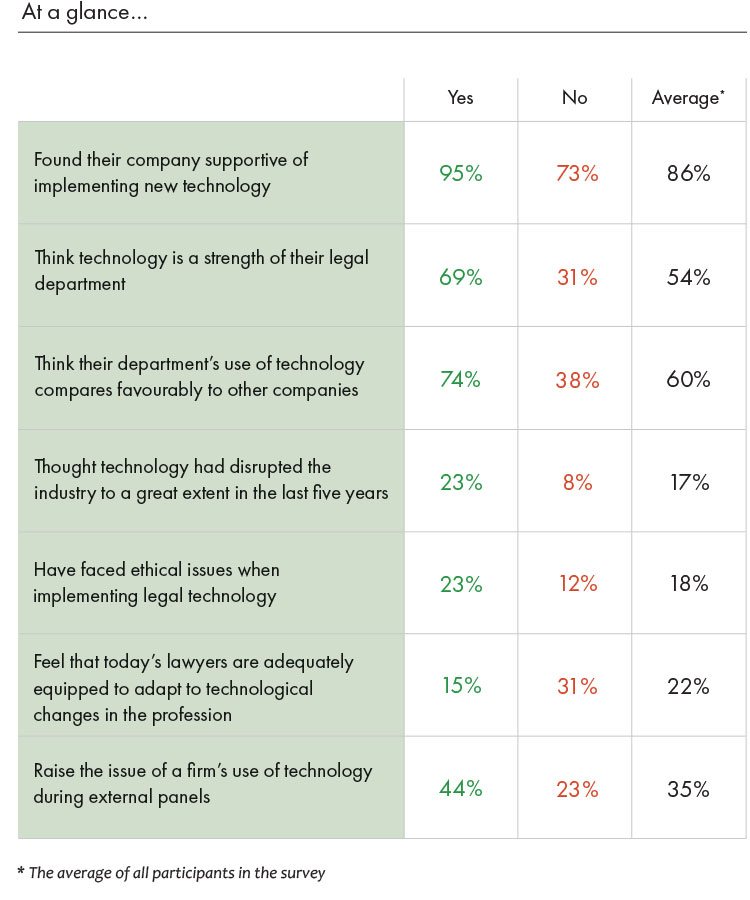My journey into an in-house legal role has not been a traditional one. I reached my current leadership position as Director of legal and institutional affairs without having any previous corporate experience. In fact, I had next to no previous experience in the private sector at all!
My career developed almost entirely in the public sector, where I focused on administrative and regulatory law. In 1991, almost exclusively I started working for the Executive National Legal Counsel and Solicitor General’s Office. This was the beginning of a career that lasted more than two decades. My roles over that time encompassed many different responsibilities, but mainly I was leading legal teams at the Ministry of Justice and the Secretariat of Human Rights, where I was the national director of legal affairs. During those years, I worked heavily in the international arena, involving topics as wide-ranging as investment protection treaties and human rights. Despite the diverse nature of those topics, they shared many common aspects: the development of complex strategies; the coordination of interdisciplinary teams for international arbitrations and trials; and human rights legal proceedings and negotiations. I learned from excellent mentors the skills I needed in cases before the International Centre for Settlement of Investment Disputes (ICSID), the Inter-American Commission and Court of Human Rights, the United Nations Human Rights Council, and Mercosur.
From a very early stage, I understood that these tasks demanded combining the law’s more technical aspects with wider political analysis and a knowledge of international relations. Thankfully, politics was not absent from my education nor from my calling.
I became a student at the School of Law of Universidad de Buenos Aires in 1985. I was part of the generation that lived during the transition to democracy, which started in 1983 with the election of President Alfonsin and ended seven long years of military dictatorship. This historic circumstance left a deep mark on law students who moved between classes and deliberation forums, thinking about the effects caused to a society whose rule of law had been substituted with terror practices. This was, definitely, the origin of my professional calling on the area of human rights, where I worked for more than 15 years as a public official, and which I continue to support even after leaving government. In fact, I currently head the regional advisory board for Latin America of the Auschwitz Institute for Peace and Reconciliation in parallel with my corporate in-house role.
Another very strong influence for me – and one which shaped the way I perceived the law at a very early stage of my career – was the opportunity to continue my academic studies at Yale University as a visiting scholar. Throughout those years, I was exposed to discussions that weren’t yet taking place in Argentina: exciting discussions about feminism, diversity, and multiculturalism. These discussions had a lasting impact on me.
After working as a government official for more than 20 years, another great challenge was put before me: I received the invitation to join an Argentinian private healthcare company to help it strengthen its in-house legal department and to help it tackle important regulatory challenges related to the business’s growth and expansion. (Healthcare is a highly-regulated industry in Argentina.) And so, in 2013, I joined Farmacity to lead its legal department. Not long after I joined, my responsibilities expanded to include leading the area of institutional relations, communication, and sustainability.
The transition from the public to the private sector was a steep learning curve for me, and involved having to adopt different cultures, languages, practices, and traditions. However, despite working in such a different environment, I realised that the training, principles, and my perspective on justice and the application for the rule of law remained the same and enabled me to adapt quickly to my new situation. I became aware that every position, every role, has been and will always be a continuous learning experience, in which the skills developed and assimilated at one time and for a specific context are adapted and used at other times and in other contexts.
In my corporate life, I find myself applying many of the skills I learned in my years as a government official: the ability to manage and resolve conflict, to lead big teams, to work under pressure, and to make decisions and face the consequences. My experience working within interdisciplinary areas also allowed me to learn vital communication skills: explaining complex legal concepts to non-lawyers, and managing interfaces between political decisions and technical structures. Those same communication skills are used daily in my job as in-house counsel. They are present in the relationships I have with external counsellors for the development of strategies, and during the decision-making process with our shareholders.
As a corporate in-house lawyer, it is important to understand who is responsible for the legal strategy or institutional decision, the scope of the external advisory services, and the way in which the in-house professional provides a unique view of the business’s needs. Also, it is vital to remember the point of view of your shareholders.
The combination of experiences I talk about are not reduced simply to the technical legal skills or qualifications I have gained. It is so much more than that. In this regard, I would like to focus on the human rights agenda – mainly in connection to the gender agenda – and the connection between cultural and societal values and beliefs, and how organisations behave.
My point of view is that the gender agenda cannot be separated from the history of my generation, nor from my professional training. Legal education and professional legal practice for women in Argentina historically reflect the same structural discrimination experienced by other professions and activities, and that women face daily in their lives outside of work as well.
Most students in schools of law in Argentina are women. However, that proportion is transformed in the labour market, where the pyramid is totally inverted. Let us specifically have a look at the proportion of women who are partners at big law firms, or the negligible proportion of women in managerial positions. Let us look at the public sector where most workers within the judicial system are women but only a small number of those women are judges – and those women judges hold office mostly at courts of first instance, seldom at courts of appeals, and where only one woman is among the justices of the Supreme Court. It is worth mentioning that only in 2004 did a woman become part of the highest court in Argentina, and only in 2009 did the School of Law from Universidad de Buenos Aires appoint a woman as dean – for the first time since it was founded in 1821.
Of course, this reality is not unique to the legal industry, not to Argentina. Across the corporate world, most of the top positions in companies are held by men. However, in the legal industry, this vertical segregation is also coupled with horizontal segregation. There are legal areas traditionally performed by women and others by men. The ‘women’s world’ of legal practice has been historically limited to family, labour, and employment law or to those areas considered protective, and related to care. At the opposite end of the spectrum, we have the world of power, dominated by men: public law, business, and diplomacy. These areas are rarely entrusted to women.
This double layer of gender segregation relies heavily on unconscious biases that support the training, recruitment, and professional development of men at the expense of women. The professional development of a woman lawyer when she graduates is different from that of men. The opportunities to study a major, to study abroad, to publish articles, to become a member of professional boards, and to attend networking activities have historically been more limited for women than for men. This is because the time for professional development often coincides with the time at which women are of reproductive age. If development opportunities occur without any accompanying active policies that allow women to balance their professional lives with their decision to become mothers – and also level caring activities between men and women – this gap will only become wider.
Inequalities and gaps are not fixed on their own. In top in-house positions, as with any other leadership role in any other organisation, corrective measures must be implemented to fix the original inequality. Organisatations should regularly review their selection and promotion processes, they should incorporate gender perspectives into their assessment processes, and they should develop policies to make work and family life compatible.
For women lawyers in in-house leadership positions, there can be an additional barrier in their way – that legal departments in companies are often support areas, and therefore outside the ‘core’ business areas, which are still very much dominated by men, and seen as men’s responsibility. This segregation is, once again, not only vertical but sometimes horizontal.
Happily, though, a new paradigm is emerging in organisations. The global women’s movement, to which Argentina constitutes no exception, is changing the way in which the gender agenda must be considered by the private sector – almost mandatorily.
Diversity, inclusion, and, in general, human rights, are not only a matter for state or international bodies, but are also starting to become part of companies’ agendas. In 2011, the United Nations issued a document of Guiding Principles on Business and Human Rights. As a consequence of that universal declaration, the topic is, little by little, moving from the periphery of the private sector’s agenda and advancing towards the center of the business. Companies that embrace diversity and inclusion are committed to broaden the scope of their human rights work; they are moving from traditionally isolated actions that were undertaken under the umbrella of corporate social responsibility, to developing a whole agenda on gender, labour conditions, diversity, and environmental protection for the entire organisation.
This is what we propose to achieve at Farmacity. For more than five years, we have been putting actions in place related to the promotion of equality and the fight against gender-based violence; to educate, prevent, sanction against, and eliminate discrimination and violence against women in any of its forms; and to create alliances with government bodies and organisations from the private sector and civil society to boost the actions carried out together within the framework of the United Nations Sustainable Development Goals. In line with our belief that words matter, we made a public declaration that Farmacity is a company with a focus on gender equality.
That said, actions speak louder than words, and so our first concrete action was developing an internal protocol for gender-based violence interventions. We established a procedure that must be followed when violence cases are detected; this includes the provision of special leave for women who are the victims of violence, and arranging assistance with the help of the legal and human resources teams, in a strictly confidential process. In collaboration with specialised institutions, we train all our personnel on gender-based violence: how to detect it and how to provide assistance to the person affected. We also contribute with public campaigns about this serious social problem, which in Argentina causes the death of one woman every 32 hours.
This was then followed by several other initiatives. In collaboration with the National Ministry of Justice, we developed a programme that trains convicted women or women recently released from prison in cosmetics and personal care. This empowers women and also provides job opportunities to an often invisible group of women that faces many different types of discrimination.
We also implemented self-assessment initiatives with the United Nations programme, which enables us to develop a sustainable equality agenda, tackling issues such as women in leadership positions and the reduction of the gender pay gap, amongst many others. These initiatives, along with others that we intend to put in place in the future, result from having an organisational culture that values and promotes an inclusive leadership, and that encourages individuals to be committed to gender equality and women’s rights.
I believe that all women who have been able to develop a successful professional career have a responsibility to our gender to offer support and guidance. The organisational culture that I am committed to promotes and encourages women in such way that they should not have to make any extra effort to demonstrate their value.
From the positions we have, we must contribute to make the road easier for future generations and I believe mentoring constitutes an essential activity within all organisations. For those who are already in senior positions, it is so important to share your experience with those starting their career, to enable an easier road, to reduce gaps, and to eliminate inequalities.






 In-house legal teams come in all shapes and sizes: some companies will have small teams, preferring instead to outsource the bulk of their work to external firms, while others have internal legal departments that would outnumber many major law firms. For the purposes of the research that underpinned this report, a small legal team is classified as one with ten or fewer members, while a large legal team is one with more than ten members.
In-house legal teams come in all shapes and sizes: some companies will have small teams, preferring instead to outsource the bulk of their work to external firms, while others have internal legal departments that would outnumber many major law firms. For the purposes of the research that underpinned this report, a small legal team is classified as one with ten or fewer members, while a large legal team is one with more than ten members.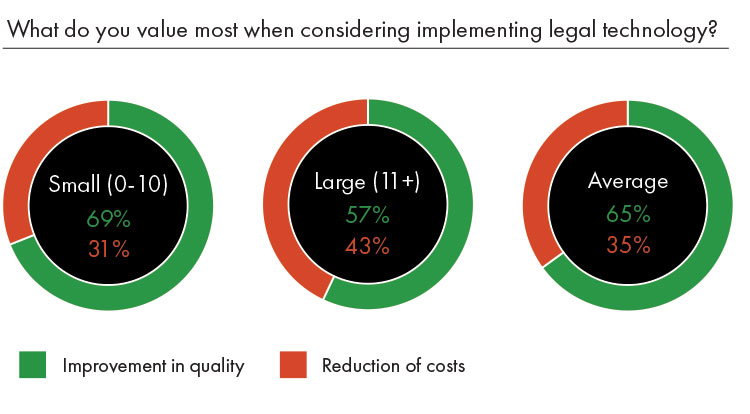

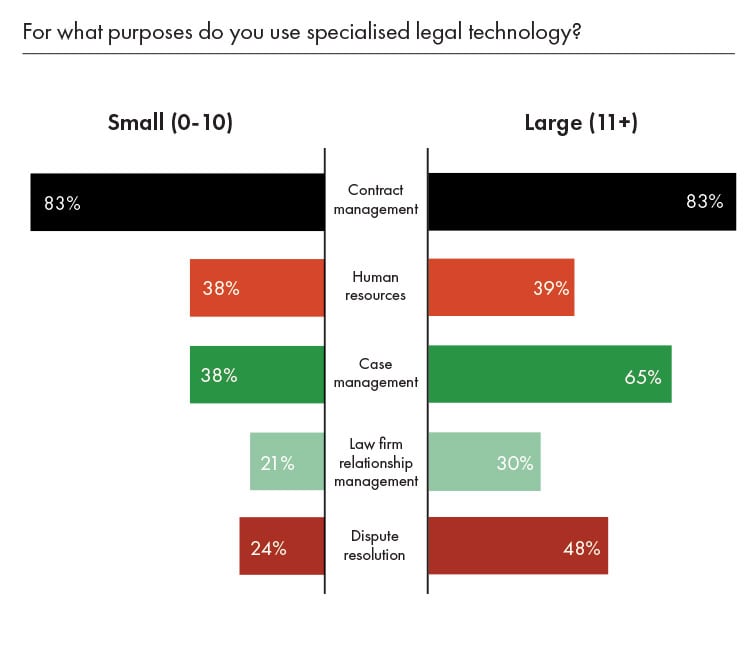

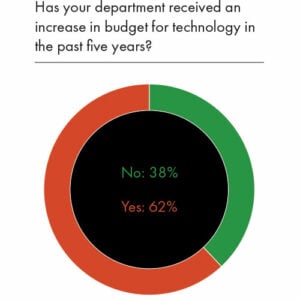 Making a first foray into legal tech can be a daunting experience for some legal departments. For a profession that (whether fairly or not) retains the reputation of being technological luddites, having the support of the wider organisation when taking the first steps with legal tech – or expanding on a positive start – can make all the difference, according to the in-house counsel that participated in our research.
Making a first foray into legal tech can be a daunting experience for some legal departments. For a profession that (whether fairly or not) retains the reputation of being technological luddites, having the support of the wider organisation when taking the first steps with legal tech – or expanding on a positive start – can make all the difference, according to the in-house counsel that participated in our research.